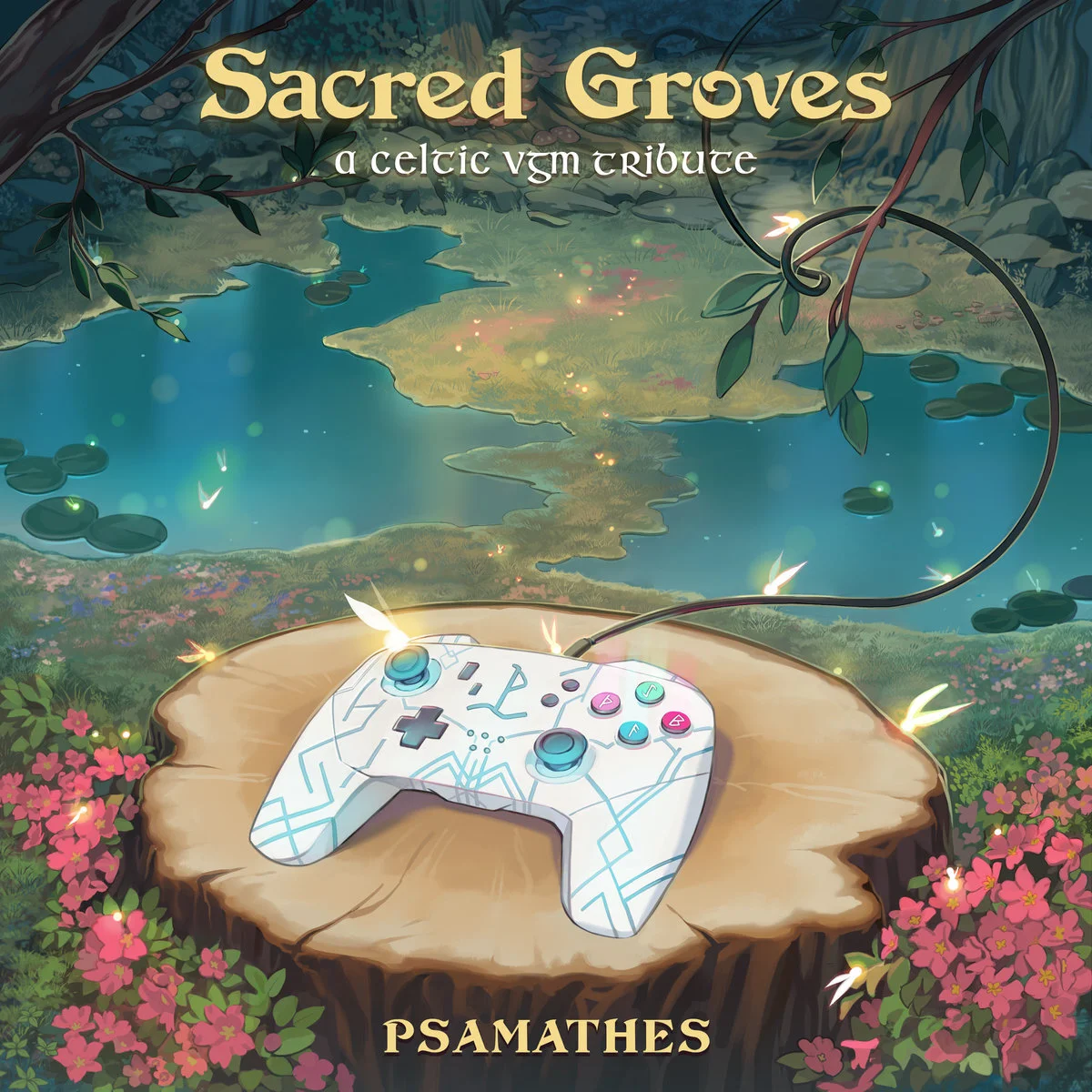Psamathes Interview: Creating 'Sacred Groves'
A “one-woman choir”, Psamathes is well-known for her powerhouse vocal performances, her frequent collaborations with VGM artists, and her love of pizza. Recently, Materia Collective announced Psamathes first solo album, Sacred Groves: A Celtic VGM Tribute, featuring tracks from the Legend of Zelda series, Undertale, Celeste, as well as several other video game titles. Judging from the preview track on Bandcamp, “Kaer Morhen”, this album will provide Psamathes a chance to flex her vocal chords as well as her skills as an arranger.
What inspired you to create a Celtic VGM album?
I’ve been developing this unique vocal style for a while, and since the response to my previous releases was always enthusiastic, I felt it could be nice to expand the concept even more and make a compilation of tracks. Singles are a great way to publish music these days, but there is always a special energy when you sit down and listen to an album for the first time, and I felt these covers deserved that kind of special treatment. Making an album also meant I could plan for more resources, for example, Duckie's stunning artwork.
How long was Sacred Groves in production?
Some of the tracks were previously released covers dating back to April 2019, but the idea to make an album came towards the end of August when I pitched the album to Materia Collective. Once my pitch was accepted, and the tracklist was set, the production of the new tracks from arrangement to mastering lasted for about a month, a month and a half at most. The older tracks mostly had some slight mixing adjustments and a few retakes, and then they were remastered by Alejandro (the mastering engineer). We had a strict deadline, and I'm so grateful for my collaborators' support because I wouldn't have made it otherwise.
Did you create the lyrics yourself? What language are they in?
Yes, they are a constructed language that I and my fans dubbed "Psamathese". It blends influences from many different languages stemming from my cultural background (Italian, Latin), my academic studies (Japanese), and my personal interests (Scandinavian languages). I really wanted something that I could adapt depending on the song.
For example, the Psamathese of “Kaer Morhen” draws a bit from the sounds of Polish and Elder Speech, while tracks like “The White Lady” are going heavy on the "fae" vibe instead. Ultimately, this language is meant to give listeners freedom of interpretation on a deeper level, conveying emotions beyond the meaning of words.
How did you choose the tracks/games that would be covered on the album?
I started with songs I had already covered and tried to find songs from other games that would fit well in the context of the album. For games like The Witcher 3 and Undertale, it was mostly a matter of including something from my favorites. Celeste and Octopath Traveler were more of a personal challenge to see if I could make those songs work in this style. Finally, “Song of Healing” was my go-to when I thought "How about some Zelda?".
The songs were also chosen for licensability, of course. I wouldn't say that factor caused me to cut anything, but it definitely helped me make a more focused search.
Were there any tracks that you wanted to cover or had to cut?
I have to say that the tracklist was pretty easy to settle upon. I initially wanted to add something from Dark Souls or Kingdom Hearts, but I eventually settled for other choices to make the album more dynamic. They're definitely gonna be covered at some point though! Maybe for a Sacred Groves Volume 2…(Editor’s Note: We can only hope!)
What were some of the biggest challenges with arranging Sacred Groves?
First of all, balancing moods. I was afraid that a completely a cappella album would become boring, so I tried to include more upbeat tracks here and there to balance the mysterious, ethereal ones. Another challenge was giving the songs a "choir" feel, and, of course, it's all about how to fill the sound with one voice. Harmonies really help with that, but what I love doing the most is singing melodies that were originally written for a different instrument.
With “Song of Healing”, I simply sang the main melody into the mic without any references or tempo mapping and then harmonized and improvised over it to build up the arrangement. The irregular tempo makes it feel almost like a live a cappella recording. In the end, the main challenge is having enough control over all the things you can do with your voice and using them all to their full extent.
Did you have to perform any unique vocal exercises in preparation for the album?
Nothing more than what I usually do. In this case, the biggest challenge in terms of technique was being able to use my full range from top (high F) to bottom (I don't remember for sure, but around C before middle C or the B right before it), so I mostly had to make sure to warm up properly without neglecting any aspect of my voice. Since I can't fill the low end of the choir like a Baritone or a Bass would, I have to make sure that however low I go has the best sound quality possible to make up for that. I also worked on my agility to make sure all the folk runs were clear and precise.
When recording so many vocals in a short period of time, it's important to rest a lot and take breaks while recording to avoid straining. I base all my different vocal styles on classical training, which prepares you to sing whole operas. Building that kind of stamina over the years has really paid off!
What were some of the biggest lessons that you learned on this album?
First of all, to ask for help. I wouldn't have made it without Materia Collective or my collaborators on both audio and artwork. I also learned that I can make a solo album, which I definitely wasn't sure of before! I learned a lot about arranging, especially how to keep a short loop interesting when you're expanding it to a 2 or 3-minute track and your only instrument is your own voice. In a way, I also learned about communicating.
Music has always supported me during difficult times, so I hope I can support whoever listens to this album too.
Why did you choose Alejandro to master Sacred Groves?
He had already done an amazing job on Icebound, so I was sure he would be great for Sacred Groves too. At first I thought I would master the album myself, but I definitely needed someone experienced to make the songs shine, and knowing that Alejandro worked with so many different genres, I was sure I could count on him.
I noticed that Duckie did the artwork. Didn't she do the artwork for Icebound as well?
I always loved Duckie's style, so I suggested her when we were thinking about the artwork for Icebound, and I thought she would be a perfect fit for Sacred Groves as well. We discussed the concept for the illustration together and she absolutely delivered! Every time I look at it, I fall in love with a new detail.
What do you hope listeners feel when they hear Sacred Groves?
I hope they feel all the passion and care I put in this project. Music has always supported me during difficult times, so I hope I can support whoever listens to this album too. This is definitely an album that works well as background music, but I hope if people take the time to delve a little deeper, they will find and appreciate all the details and emotions I poured into Sacred Groves.
Do you have any final thoughts about the album?
I'm just really proud of how it came out and grateful to all the awesome people that helped me make it happen! I hope it can inspire more people to discover the games I covered and to appreciate the potential of the voice as an instrument.
Look for a full GameGrooves review when Sacred Groves releases this Friday!
Purchase/Preview Sacred Groves Today!
Album art by Duckie.

